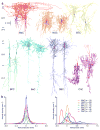The organization of two new cortical interneuronal circuits
- PMID: 23313910
- PMCID: PMC3589105
- DOI: 10.1038/nn.3305
The organization of two new cortical interneuronal circuits
Erratum in
- Nat Neurosci. 2013 Dec;16(12):1908
Abstract
Deciphering the interneuronal circuitry is central to understanding brain functions, yet it remains a challenging task in neurobiology. Using simultaneous quadruple-octuple in vitro and dual in vivo whole-cell recordings, we found two previously unknown interneuronal circuits that link cortical layer 1-3 (L1-3) interneurons and L5 pyramidal neurons in the rat neocortex. L1 single-bouquet cells (SBCs) preferentially formed unidirectional inhibitory connections on L2/3 interneurons that inhibited the entire dendritic-somato-axonal axis of ∼1% of L5 pyramidal neurons located in the same column. In contrast, L1 elongated neurogliaform cells (ENGCs) frequently formed mutual inhibitory and electric connections with L2/3 interneurons, and these L1-3 interneurons inhibited the distal apical dendrite of >60% of L5 pyramidal neurons across multiple columns. Functionally, SBC→L2/3 interneuron→L5 pyramidal neuronal circuits disinhibited and ENGC↔L2/3 interneuron→L5 pyramidal neuronal circuits inhibited the initiation of dendritic complex spikes in L5 pyramidal neurons. As dendritic complex spikes can serve coincidence detection, these cortical interneuronal circuits may be essential for salience selection.
Conflict of interest statement
The authors declare no competing financial interests.
Figures








Comment in
-
The yin and yang of cortical layer 1.Nat Neurosci. 2013 Feb;16(2):114-5. doi: 10.1038/nn.3317. Nat Neurosci. 2013. PMID: 23354381 No abstract available.
Similar articles
-
Canonical Organization of Layer 1 Neuron-Led Cortical Inhibitory and Disinhibitory Interneuronal Circuits.Cereb Cortex. 2015 Aug;25(8):2114-26. doi: 10.1093/cercor/bhu020. Epub 2014 Feb 18. Cereb Cortex. 2015. PMID: 24554728 Free PMC article.
-
Cortical inhibitory cell types differentially form intralaminar and interlaminar subnetworks with excitatory neurons.J Neurosci. 2009 Aug 26;29(34):10533-40. doi: 10.1523/JNEUROSCI.2219-09.2009. J Neurosci. 2009. PMID: 19710306 Free PMC article.
-
Diversity and Connectivity of Layer 5 Somatostatin-Expressing Interneurons in the Mouse Barrel Cortex.J Neurosci. 2018 Feb 14;38(7):1622-1633. doi: 10.1523/JNEUROSCI.2415-17.2017. Epub 2018 Jan 11. J Neurosci. 2018. PMID: 29326172 Free PMC article.
-
Inhibitory Circuits in Cortical Layer 5.Front Neural Circuits. 2016 May 6;10:35. doi: 10.3389/fncir.2016.00035. eCollection 2016. Front Neural Circuits. 2016. PMID: 27199675 Free PMC article. Review.
-
Local connections of excitatory neurons in motor-associated cortical areas of the rat.Front Neural Circuits. 2013 May 28;7:75. doi: 10.3389/fncir.2013.00075. eCollection 2013. Front Neural Circuits. 2013. PMID: 23754982 Free PMC article. Review.
Cited by
-
Functional diversities within neurons and astrocytes in the adult rat auditory cortex revealed by single-nucleus RNA sequencing.Sci Rep. 2024 Oct 25;14(1):25314. doi: 10.1038/s41598-024-74732-7. Sci Rep. 2024. PMID: 39455606 Free PMC article.
-
Functional response properties of VIP-expressing inhibitory neurons in mouse visual and auditory cortex.Front Neural Circuits. 2015 May 22;9:22. doi: 10.3389/fncir.2015.00022. eCollection 2015. Front Neural Circuits. 2015. PMID: 26106301 Free PMC article.
-
Homogeneous and Narrow Bandwidth of Spike Initiation in Rat L1 Cortical Interneurons.Front Cell Neurosci. 2020 Jun 17;14:118. doi: 10.3389/fncel.2020.00118. eCollection 2020. Front Cell Neurosci. 2020. PMID: 32625063 Free PMC article.
-
Neocortical Layer 1: An Elegant Solution to Top-Down and Bottom-Up Integration.Annu Rev Neurosci. 2021 Jul 8;44:221-252. doi: 10.1146/annurev-neuro-100520-012117. Epub 2021 Mar 17. Annu Rev Neurosci. 2021. PMID: 33730511 Free PMC article.
-
Thalamocortical Innervation Pattern in Mouse Auditory and Visual Cortex: Laminar and Cell-Type Specificity.Cereb Cortex. 2016 Jun;26(6):2612-25. doi: 10.1093/cercor/bhv099. Epub 2015 May 15. Cereb Cortex. 2016. PMID: 25979090 Free PMC article.
References
-
- McBain CJ, Fisahn A. Interneurons unbound. Nature reviews. Neuroscience. 2001;2:11–23. - PubMed
-
- Markram H, et al. Interneurons of the neocortical inhibitory system. Nature reviews. Neuroscience. 2004;5:793–807. - PubMed
-
- Bartos M, Vida I, Jonas P. Synaptic mechanisms of synchronized gamma oscillations in inhibitory interneuron networks. Nature reviews. Neuroscience. 2007;8:45–56. - PubMed
Publication types
MeSH terms
Grants and funding
LinkOut - more resources
Full Text Sources
Other Literature Sources
Research Materials

